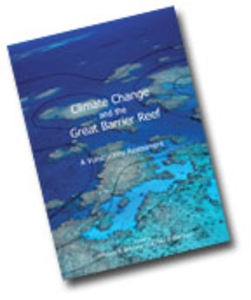Vulnerability of geomorphological features in the Great Barrier Reef to climate change
Smithers, Scott G., Harvey, Nick, Hopley, David, and Woodroffe, Colin D. (2007) Vulnerability of geomorphological features in the Great Barrier Reef to climate change. In: Johnson, Johanna E., and Marshall, Paul A., (eds.) Climate Change and the Great Barrier Reef: a vulnerability assessment. Great Barrier Reef Marine Park Authority and Australian Greenhouse Office, Townsville, QLD, Australia, pp. 667-716.
|
PDF (Published Version)
- Published Version
Download (1MB) |
|
![[img]](https://researchonline.jcu.edu.au/1837/2.hassmallThumbnailVersion/1837%2C_5189%2C_8060%2C_8488%2C_8566%2C_12118_Climate_Change_GBR_2007_cover.jpg)
|
Image (JPEG) (Book Cover)
- Cover Image
Download (8kB) |
Abstract
The geomorphology and ecology of the GBR are strongly interdependent – the reefs are almost entirely the skeletal remains of a myriad of calcium carbonate secreting fauna and flora. A suite of organisms and ecological processes are involved in the production, consolidation, modification and redistribution of these products to form many of the GBR’s geomorphological features. Conversely, geomorphological features are important to reef ecology. They physically structure habitats for various biota and influence the distribution of physical processes (such as waves and currents) important to many reef organisms. At a larger scale, outer reefs separate the inner lagoon and open ocean, and control cross-shelf hydrodynamic energy gradients important for many species. Biogeographic and other influences are important156, but the extraordinary habitat complexity and biological diversity found on the GBR can be largely attributed to the geographical opportunities of latitudinal and cross-shelf gradients provided by its impressive scale. This chapter provides an overview of the vulnerability to climate change of five of the GBR’s major geomorphological features: i) coral reefs, ii) reef islands, iii) high island beaches and spits, iv) mainland sandy coasts, and v) mainland muddy coasts. The vulnerability of biota associated with these features is assessed in other chapters (Lovelock and Ellison chapter 9, Hoegh-Guldberg et al. chapter 10, Congdon et al. chapter 14, Fabricius et al. chapter 17, Sheaves et al. chapter 19 and Turner and Batianoff chapter 20). Vulnerability is defined as the degree to which a system or species is susceptible to, or unable to cope with, the adverse effects of climate change.
| Item ID: | 1837 |
|---|---|
| Item Type: | Book Chapter (Non-Commercial) |
| ISBN: | 978-1-87-694561-9 |
| Keywords: | Great Barrier Reef, climate change, geomorphology, reef islands, cays, sea level change |
| Date Deposited: | 05 Mar 2008 |
| FoR Codes: | 04 EARTH SCIENCES > 0406 Physical Geography and Environmental Geoscience @ 0% 04 EARTH SCIENCES > 0406 Physical Geography and Environmental Geoscience > 040601 Geomorphology and Regolith and Landscape Evolution @ 0% 04 EARTH SCIENCES > 0403 Geology > 040310 Sedimentology @ 0% |
| Downloads: |
Total: 8406 Last 12 Months: 26 |
| More Statistics |



